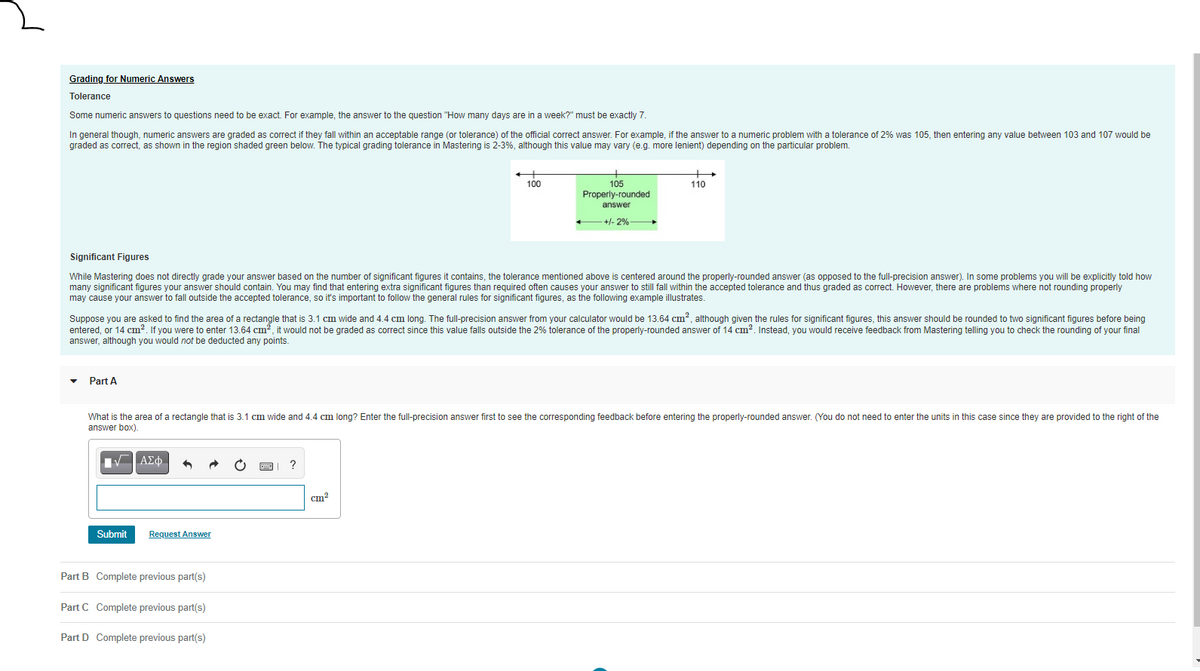What is the area of a rectangle that is 3.1 cm wide and 4.4 cm long? Enter the full-precision answer first to see the corresponding feedback before entering the properly-rounded answer. (You do not need to enter the units in this case since they are provided to the right of the answer box). cm2 Submit Request Answer
What is the area of a rectangle that is 3.1 cm wide and 4.4 cm long? Enter the full-precision answer first to see the corresponding feedback before entering the properly-rounded answer. (You do not need to enter the units in this case since they are provided to the right of the answer box). cm2 Submit Request Answer
University Physics Volume 1
18th Edition
ISBN:9781938168277
Author:William Moebs, Samuel J. Ling, Jeff Sanny
Publisher:William Moebs, Samuel J. Ling, Jeff Sanny
Chapter1: Units And Measurement
Section: Chapter Questions
Problem 10CQ: For each of the following scenarios, refer to Figure 1.4 and Table 1.2 to determine which metric...
Related questions
Question

Transcribed Image Text:Grading for Numeric Answers
Tolerance
Some numeric answers to questions need to be exact. For example, the answer to the question "How many days are in a week?" must be exactly 7.
In general though, numeric answers are graded as correct if they fall within an acceptable range (or tolerance) of the official correct answer. For example, if the answer to a numeric problem with a tolerance of 2% was 105, then entering any value between 103 and 107 would be
graded as correct, as shown in the region shaded green below. The typical grading tolerance in Mastering is 2-3%, although this value may vary (e.g. more lenient) depending on the particular problem.
100
105
Properly-rounded
110
answer
+/- 2%
Significant Figures
While Mastering does not directly grade your answer based on the number of significant figures it contains, the tolerance mentioned above is centered around the properly-rounded answer (as opposed to the full-precision answer). In some problems you will be explicitly told how
many significant figures your answer should contain. You may find that entering extra significant figures than required often causes your answer to still fall within the accepted tolerance and thus graded as correct. However, there are problems where not rounding properly
may cause your answer to fall outside the accepted tolerance, so it's important to follow the general rules for significant figures, as the following example illustrates.
Suppose you are asked to find the area of a rectangle that is 3.1 cm wide and 4.4 cm long. The full-precision answer from your calculator would be 13.64 cm?, although given the rules for significant figures, this answer should be rounded to two significant figures before being
entered, or 14 cm?, If you were
answer, although you would not be deducted any points.
o enter 13.64 cm², it would not be graded as correct since this value falls outside the 2% tolerance of the properly-rounded answer of 14 cm?. Instead, you would receive feedback from Mastering telling you to check the rounding of your final
Part A
What is the area of a rectangle that is 3.1 cm wide and 4.4 cm long? Enter the full-precision answer first to see the corresponding feedback before entering the properly-rounded answer. (You do not need to enter the units in this case since they are provided to the right of the
answer box).
cm?
Submit
Request Answer
Part B Complete previous part(s)
Part C Complete previous part(s)
Part D Complete previous part(s)
Expert Solution
This question has been solved!
Explore an expertly crafted, step-by-step solution for a thorough understanding of key concepts.
This is a popular solution!
Trending now
This is a popular solution!
Step by step
Solved in 2 steps with 2 images

Knowledge Booster
Learn more about
Need a deep-dive on the concept behind this application? Look no further. Learn more about this topic, physics and related others by exploring similar questions and additional content below.Recommended textbooks for you

University Physics Volume 1
Physics
ISBN:
9781938168277
Author:
William Moebs, Samuel J. Ling, Jeff Sanny
Publisher:
OpenStax - Rice University

College Physics
Physics
ISBN:
9781305952300
Author:
Raymond A. Serway, Chris Vuille
Publisher:
Cengage Learning

College Physics
Physics
ISBN:
9781285737027
Author:
Raymond A. Serway, Chris Vuille
Publisher:
Cengage Learning

University Physics Volume 1
Physics
ISBN:
9781938168277
Author:
William Moebs, Samuel J. Ling, Jeff Sanny
Publisher:
OpenStax - Rice University

College Physics
Physics
ISBN:
9781305952300
Author:
Raymond A. Serway, Chris Vuille
Publisher:
Cengage Learning

College Physics
Physics
ISBN:
9781285737027
Author:
Raymond A. Serway, Chris Vuille
Publisher:
Cengage Learning

Principles of Physics: A Calculus-Based Text
Physics
ISBN:
9781133104261
Author:
Raymond A. Serway, John W. Jewett
Publisher:
Cengage Learning

Physics for Scientists and Engineers with Modern …
Physics
ISBN:
9781337553292
Author:
Raymond A. Serway, John W. Jewett
Publisher:
Cengage Learning

Physics for Scientists and Engineers
Physics
ISBN:
9781337553278
Author:
Raymond A. Serway, John W. Jewett
Publisher:
Cengage Learning